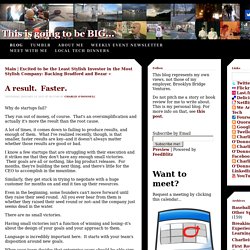Milestones / metrics
> Startup library
> Management
A result. Faster.
Why do startups fail?

They run out of money, of course. That's an oversimplification and actually it's more the result than the root cause. A lot of times, it comes down to failing to produce results, and enough of them. What I've realized recently, though, is that smaller, faster results are key--and it doesn't always matter whether those results are good or bad.
I know a few startups that are struggling with their execution and it strikes me that they don't have any enough small victories. Similarly, they get stuck in trying to negotiate with a huge customer for months on and end it ties up their resources. Even in the beginning, some founders can't move forward until they raise their seed round. There are no small victories. Having small victories isn't a function of winning and losing--it's about the design of your goals and your approach to them. Language is incredibly important here. When your team decides that enterprise users should be able sign themselves up, that's a big project.
The only metric that matters. I've been lucky to be part of the early growth of several really interesting and now important networks including LinkedIn, Facebook, and Twitter.

One of the things that I felt working on each of these is that we never looked at numbers or metrics in the abstract -- total page views, logged in accounts, etc, but we always talked about users. More specifically, what they were doing and why they were doing it. At LinkedIn we didn't talk about "total page views", but instead "profile views" - how many people were using LinkedIn to search for and find other people, and how many people were on LinkedIn being viewed. At Twitter while we had (and they still have) crazy page view numbers, we talked instead about how many people were looking at their timeline and reading tweets or tweeting.
When I meet new companies today, I often hear things like "We have 10M uniques with 30M page views per month.
"
A mile wide, an inch deep. The problem with time, though, is it’s not actually measuring value.

It’s measuring cost as a proxy for value. Advertisers don’t really want your time — they want to make an impression on your mind, consciously or subconsciously (and, ultimately, your money). As the writer of this piece, I don’t really want your time — I want to make an impression on how you think. If my rhetorical skills let me do that in less time (for me and you), all the better. At Medium, we don’t really want anyone’s time. What if there was some new genre or form or author on Medium that was incredibly addictive and popular but, to our minds, didn’t seem of significant value or lasting import? This is the problem with any one-dimensional metric.
What are typical Key Perfomance Indicators for a web product?
Engagement: The leading indicator of product-market fit. So now that we know what’s engagement and how to measure it, how do we drive it?

User engagement can be categorized in one of two types: Natural and Manufactured. Natural engagement is the result of the derived benefit (or value) from using your product or service. This is the most important form of engagement, and if you don’t have a set of customers in this category you could infer that you haven’t really found product-market fit. A few years back I attended a conference in which Dick Hardt made an awesome analogy to categorize products. He suggested that products could be categorized as vitamins, pain killers, or viagra. Vitamins are products that, in theory, are good for you, but their benefits aren’t visible immediately. “Pain killers” and “viagra” products or services drive more natural engagement than “vitamin” products. Below is a non exhaustive list of ways to manufacture engagement.
Vanity milestones. Startup Metrics for Pirates (KAUST, Nov 2013)
Dave McClure - Startup Metrics For Pirates @ Techaviv.




